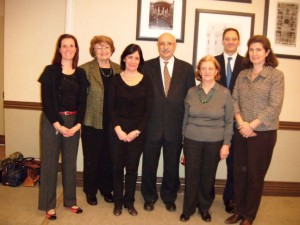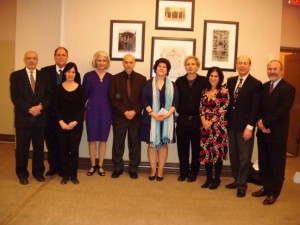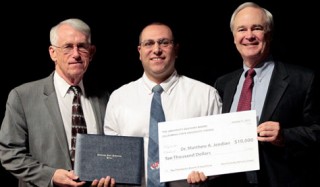BY Florence Avakian
COLUMBIA UNIVERSITY, NY—-It was an extraordinary evening of revelation, as Dr. Levon Avdoyan unveiled the large trove of Armenian treasures in the Library of Congress where he serves as Specialist of the Armenian and Georgian areas. Entitled “To Know Wisdom and Instruction”, his fascinating talk covered 500 years of Armenian printing, and a history of the Armenian collection at the Library of Congress. Starting on April 19, 2012, an exhibition of the collection of Armenian manuscripts and printed books will be open to the public for five months.
He is also preparing an exhibition catalog which will be published in time for the opening of the exhibition. The Library of Congress is the largest library in the world, and the Armenian collections have now become a major source for Armenioajn studies and research.


It was also an evening of appreciation as Michael Haratunian, longtime Chairman of the Columbia University Armenian Center Board of Directors, was honored. Following a warm welcome to the enthusiastic audience of more than a hundred by the current Chairman of the Armenian Center Mark Momjian, a special tribute was accorded by Board member Dr. Nicole Vartanian to Michael Haratunian who was presented the first edition (1934) of Franz Werfel’s The Forty Days of Musa Dagh.
In his remarks of gratitude, Haratunian recounted the rich tradition of the Armenian Studies program at Columbia University, starting with the announcement of the Armenian Chair in 1979 by then Columbia President McGill. Dr. Nikit and Eleanora Ordjanian raised it to a permanent endowment at Columbia College with Kevork Avedisian funding with a million dollar donation the Chair of Armenian Studies. This was followed by Sarkis Agopian funding the Armenian collection, Suren Fesjian funding the publications, and Krikor and Clara Zohrab Liebman providing full tuition for Armenian graduate students which currently totals in the millions of dollars.


Dr. Avdoyan was introduced by Armenian Center Board member Lola Koundakjian who related his impressive background which includes a doctorate in Ancient History and Armenian Studies from Columbia University under Professors Nina Garsoian and Morton Smith; joining the Library of Congress in 1977, and becoming its Specialist for Ancient Classical History, and Byzantine and Medieval Studies in 1982; and finally its Area Specialist for Armenia and Georgia in 1992. He is also the author of the entire illustrated guide of the Library of Congress’ Near East collection, as well as of many scholarly monographs and articles.
ARMENIA AT THE WORLD’S LARGEST LIBRARY
Dr. Avdoyan announced that the extraordinary exhibition that will open at the Library of Congress on April 19, 2012, entitled “To Know Wisdom and Instruction: The Armenian Literary Tradition at the Library of Congress”, will use the Library of Congress’ Armenian collection to illustrate the Armenian literary tradition. He is also preparing an exhibition catalog which will be published in time for the opening of the exhibition. “The Library of Congress is the largest library in the world, and the Armenian collections have now become a major source for Armenian studies and research,” he added with understandable pride.
He revealed that many of the works about Armenians were not written by Armenians, but nonetheless are very valuable. “ Yerevan itself will celebrate the 500th anniversary of the printing of Armenian books in 2012,” he stated.
The scholar pointed out that the Library of Congress was founded in 1800 to serve the U.S. Congress, but evolved into the national library. It is the oldest cultural institution in the federal government, and comprises three huge buildings, and a huge campus for motion pictures and recorded sound with 155 million items with an estimated 560 miles of shelves. “And over sixty percent of the material is not written in English,” he added.
Due to the political and economic conditions, the publication of Armenian books could not begin in the homeland, but started in the diaspora as a result of the fall of Cilician Armenia in 1375 A.D., he related. “Armenian was the second Middle Eastern language to be published, Hebrew in 1472 being the first.” In 1512, Jacob the Sinner opened the press in Venice and published five printed books. And in America, although the first printed books by Armenians started in the 19th century by the various Biblical societies for missionary work abroad, the first work in Armenian for American-Armenians was published in 1888.
The first massive collection of Armenian works at the Library of Congress took place in the late 19th century. It continued with “dribs and drabs” until 1948, when the “Committee for the Armenian Collection” created by Arthur H. Dadian and including the legendary scholar Dr. Sirarpie der Nercessian, it grew from some 250 to 6000 items in the Armenian language collection. By 1992, when Dr. Avdoyan was appointed Armenian Specialist, the collection had grown to 7000 items. “Today,” he said, “there are estimated to be from 40,000 to 45,000 Armenian works.”
Using a power point presentation, he showed pages of the oldest gospel book printed in 1321 A.D., the 1487 Verin Noravank Gospel with its gorgeous pigmentation, the Bible of Mkhitar of Sivas (1733), the ecclesiastical fabric dedicated to St. Karapet in 1741, and documents and posters from the Near East Relief. There were also 1859 photos of Armenian cotton cultivation from Paris; a photo of Lady Azgapetyan who in 1919 was the first woman to represent Armenia at the World Suffragettes’ Conference in Paris; and even an item of firefighting in Armenia.
He noted that that there are no photos from the time of the Armenian Genocide, but there are several from before and after the catastrophe. Also in the collection are many Armeno-Turkish books, including the 13-volume diary of Tavit Adamian who went through the Genocide and emigrated to Boaston. There is also a letter in the Alexander Graham Bell Archives describing the Genocide in Adana in 1909, as well as Talaat Pasha’s note of thanks to U.S. Ambassador Henry Morgenthau for hosting a dinner on the eve of the Genocide, April 24, 1915, and the many Morgenthau telegrams to the State Department.
“The Library of Congress has the largest map repository in the world,” including the first published map of Yerevan published in 1920 before the fall of the First Republic, he continued.
Rare books abound at the Library of Congress, Dr. Avdoyan revealed, including the Book of Prayers from Krikor Naregatsi (1763); a collection of stereographic images; a manuscript of astrology; postal stamps; Verk Hayastani, the first novel of Khachadour Abovyan (1959); and a huge collection of memorial books by immigrants who wrote about their homeland.
START OF DIGITAL AREA
From the time of the Book of Fridays to the period of publication in the current Republic of Armenia, the presses have always remained active, he pointed out. “We’re at the start of the digital area,” he said, adding that only ten percent of the Library of Congress is digitized. In response to a question asking what sorts of collection should be digitized, he made3 several suggestions, including the need for primary documentation on the First Reoublic of Armenia.
The significant evening ended with Mark Momjian quoting Thomas Jefferson who said, “I cannot live without books.” He then presented Dr. Avdoyan with Christopher Oscanyan’s The Sultan and His People. Published in New York in 1857, it is probably the first book printed in the United States by an Armenian author.










